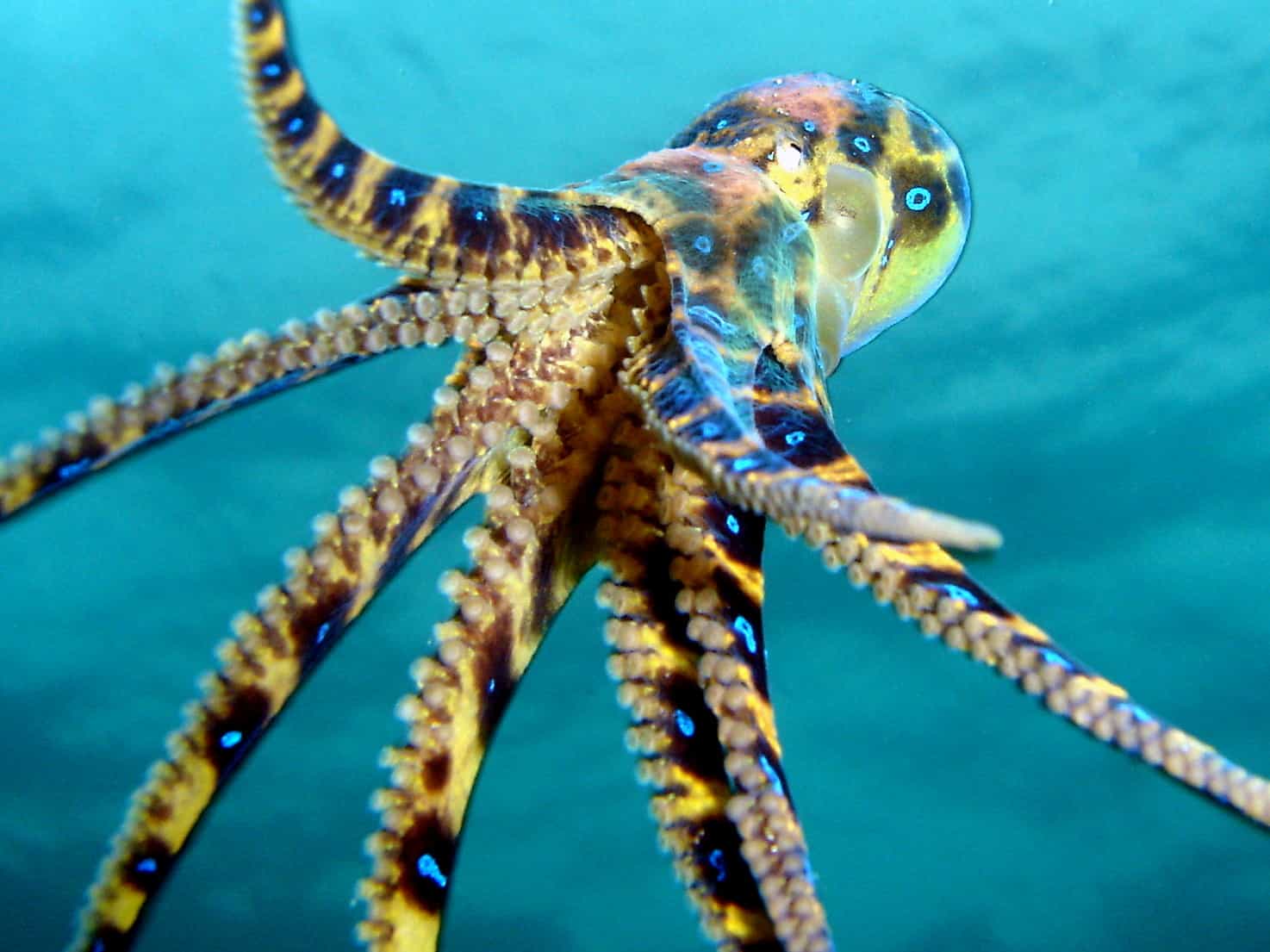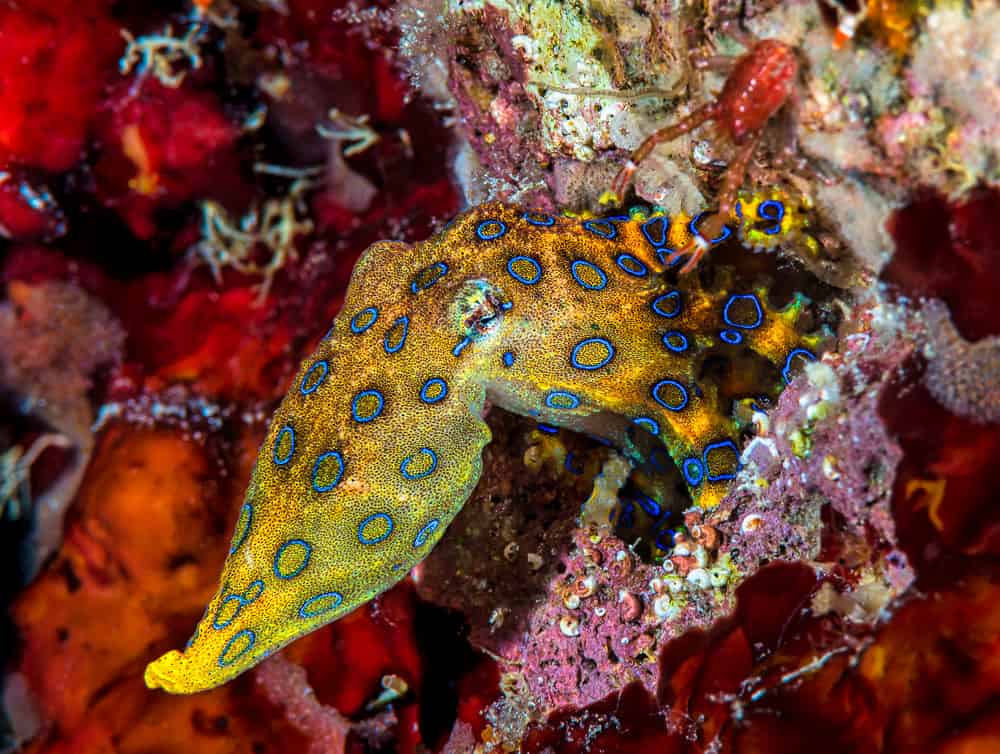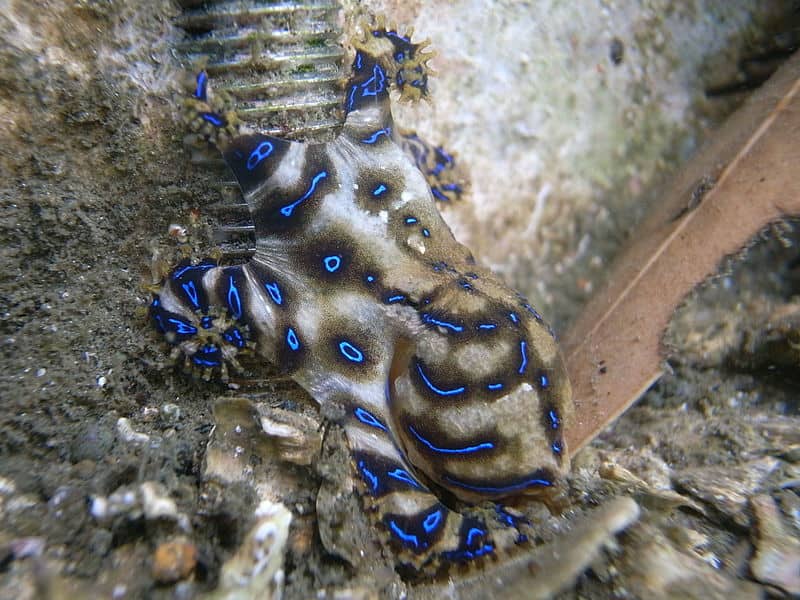
The blue-ringed octopus is one of the most striking creatures that live in the sea. You can find it in the warm, shallow waters of the Pacific, a vibrant underwater realm stretching from Australia to Japan. The octopus is small enough to fit into the palm of your hand, and its beauty is bewitching. But don’t let the creature’s petite size and enchanting appearance fool you. The blue-ringed octopus packs a venomous punch. It holds enough poison to take down 26 humans within minutes.
Absolutely stunning but deadly to the touch, meet one of the most beautiful cephalopods in the world, the blue-ringed octopus (Hapalochlaena sp.).
The Blue-Ringed Octopus
How big are they?
These octopi are tiny little critters. They only measure up to 20 cm! As a matter of fact, generally, they’re usually on the lower end of that figure, and only measure about 12 cm long. So far, we know there are at least 10 species of these mollusks out in the world – although only 4 have been scientifically described.
Fun fact: Each of these 10 species is small enough to fit in the palm of a hand, yet they all carry enough venom to kill an average human.

What do they eat?
Although tiny, blue-ringed octopi are actually pretty skilled hunters. They’ll catch crustaceans, other smaller mollusks and even run around after small fish.
The blue-ringed octopus eats fish and shellfish by ambushing them, using its arms to draw the prey toward its beak. It then injects venom through the prey’s tough shell to paralyze and kill it. Normally yellow with dark brown rings, the octopus changes color when threatened. This color shift is due to special ink-filled sacs beneath its skin called chromatophores. When the octopus senses danger, these sacs stretch, making its rings turn a bright neon blue. Once the threat is gone, the sacs contract and the color returns to normal.
Where do they live?
These adorable little mollusks love hanging out in shallow waters, usually no deeper than 20 meters. They generally shack up in any tiny nook and cranny they can find themselves; crevices, cracks, and fissures of habitats like intertidal pools and shallow coral reefs are all fair game.
How do they hunt?
These invertebrates love sneaking up on their prey. Similar to most types of cephalopods, blue-ringed octopi love themselves a bit of ambush hunting. Typically, these octopi don’t waste time running around after prey. (Remember, octopi are some of the smartest animals out there.)
Rather, these animals prefer staying put and stationary. They wait for their prey to come close to them. Once at a suitable distance, they pounce and pierce their prey with their venomous beak.

How do they reproduce?
It’s generally common for lower marine invertebrates to adopt a hermaphroditic way of life. Here again, cephalopods diverge from the general ways of invertebrate life.
Sexually mature at 1 and dead by 2, blue-ringed octopi live short but exciting lives. Generally a solitary species, these octopi hang around ambush-hunting hermit crabs or laying low in crevices till they sexually mature at 1. Then, sexually mature males venture out, in search of suitable females.
When it comes to mating, blue-ringed octopuses do it up pretty unsettlingly. First off, let’s cover the basics; each octopus has 8 arms. Now diving into the nitty-gritty of octopus morphology, the third arm of every male octopus in the world is a penis (scientifically referred to as the hectocotylus).
Then, once a male zeroes in on his female of preference, he proceeds to pounce on her to insert his arm-penis (hectocotylus) into the female’s mantle cavity — a pouch-like and hollow space that holds not just the reproductive organs but the brain, stomach, and intestines, kidney, live, and gills as well!
If the previous sentence baited you into reading further, get ready because the upcoming fact might just fully reel you in – once mating is successful, the female lays anywhere between 50 to 100 eggs but here’s the catch; the eggs are venomous. Unfortunately, the tale of almost all octopus sex is sad. Both males and females die pretty quickly after mating.
Females last longer, as they strive to protect their brood of eggs with as much ferocity as they can muster however due to the tiny inconvenience of never actually feeding on anything while doing so; females die sometime after their eggs finally hatch.
The origin of their name and its significance
Blue-ringed octopi get their name from the blue rings that adorn their bodies. But there’s a catch: Blue-ringed octopi aren’t always blue-ringed octopi.
This is because these marine invertebrates only show off their trippy blue-ringed forms when they’re exposed to vulnerable situations.
So, in other words, it’s one of those misleading animal names that isn’t necessarily true.
Blue-Ringed Octopus Facts

- Having gained the adorable and venomous blue rings that give them their name, blue-ringed octopi lose out on one of the most generic traits of being an octopi; they can’t squirt ink!
- In the case of an Animal Planet-style “War of the Blue-ringed Octopi” situation, blue-ringed Octopi might have to resort to using one of their many arms to slap each other. This is because, funnily enough, a blue-ringed octopus’ venom is useless when used on a blue-ringed octopus. They’re immune to it.
- Blue-ringed octopi may be invulnerable to their own venom but you aren’t. As a matter of fact, there’s no known anti-venom to their venom to date!
- Blue-ringed octopi aren’t the only bad boys in the animal kingdom with this unique venom. As a matter of fact, this particular venom, tetrodotoxin was first discovered in pufferfish. Tetrodotoxin isn’t even exclusive to just marine creatures, they’re found in amphibians like frogs and newts as well.
- Although the sexes are separate, male blue-ringed octopuses have a tough time telling them apart. Research says most male blue-ringed octopus actually can’t distinguish between males or females and will readily insert their hectocotylus into either sex.
Recent Studies
Due to the wide distribution as well as a lack of conservation pressures, most research centered around blue-ringed octopi concerns their toxicology; however, one interesting study from 2013 explored a unique connection between a particular human phobia (trypophobia, the fear of hole patterns) and blue-ringed octopi!
The study from the University of Essex, conducted by two psychologists (Geoff Cole and Arnold Wilkins) explained that trypophobia may actually have come about as an evolutionary reaction to any kind of visual features that remind us of toxic or venomous animals like the blue-ringed octopus.
When a participant in the trypophobia study revealed to Cole that he’d developed trypophobia post coming across a blue-ringed octopus – the researcher had a bit of a Eureka moment that led him to connect the dots (pun intended) between the visual features associated with toxic animals and people that suffered trypophobia.
In a news release from 2013, Cole and Wilkins released their findings that suggested an ancient evolutionary connection that uncovered how human brains processed visual cues that signaled the venomous or poisonous nature of animals.
“These findings suggest that there may be an ancient evolutionary part of the brain telling people that they are looking at a poisonous animal,” according to Cole.
Conservation Status
Are Blue-Ringed Octopuses endangered or rare?
Blue-ringed octopuses are listed as least concerned species by the IUCN. They also have no listed threats – other than climate change. Essentially, there’s plenty of these little critters swimming out there in the Indian and Pacific Oceans. Due to their ubiquitous nature, there aren’t any specific conservation or management plans in place for the animals just yet.
Are Blue-Ringed Octopuses Dangerous (to Humans)?
Suppose you’ve just been bitten by this cute little critter. You may be wondering…what now?
Well, I regret to tell you, it ain’t pretty. Early symptoms of a bite include everything from profuse sweating, nausea, and headaches, to excess saliva production and loss of vision. Multiple people also report instances of stomach cramps as well.
Since there’s actually no antidote or antivenom to tetrodotoxin, there’s really not much doctors can do beyond supplying you with extra oxygen or intravenous fluids. However, don’t worry. So far, there have only been a handful (or fewer) deaths caused by blue-ringed octopus bites — most people bitten make it through alive with timely medical intervention. Just don’t overlook the risk!
In fact, even when you don’t go looking for it, the blue-ringed octopus can still get you. This is because they prefer shallow, perfect for wading or swimming levels of water. So next time you’re hanging around the waters of the Indian or Pacific oceans (say, you’re on holiday in Sri Lanka or Australia), be more mindful than to go randomly looking around ditches and tidepools for seashells.
How venomous is the blue-ringed octopus?
The blue-ringed octopus is pretty venomous. As a matter of fact, a few studies have even claimed that tetrodotoxin, the neurotoxin found in blue octopus venom, may be 1,000 times more dangerous and potent than cyanide.
Although their venom, tetrodotoxin is found in the venom of a range of animals (from frogs to pufferfish) where these octopi differ is in the quantity of tetrodotoxin present in their venom. Blue-ringed octopi have a much higher amount of tetrodotoxin in their venom than other species of animals yet funnily enough they may not even be making it themselves. Rather, a strain of symbiotic bacteria found in their salivary glands has been suggested as the producers of tetrodotoxin in their bodies.
Blue-Ringed Octopus Pictures (and videos)
Attribution: Jens Petersen. https://commons.wikimedia.org/wiki/File:Hapalochlaena_lunulata2.JPG
Conclusion
The blue-ringed octopus is a paradox wrapped in a mystery, sporting colors that captivate the eye and venom that paralyzes the body. This small but formidable cephalopod serves as a potent reminder that nature often hides its deadliest secrets behind a veneer of beauty. The same animal that has fascinated scientists for its complex behaviors and unique venom also serves as a cautionary tale for ocean explorers.
These cute little critters will literally light up with their brightly colored rings when threatened or disturbed so even though literally every species of this particular octopus can fit in the palm of your hand – DO NOT PICK THEM UP. Not all that is Instagrammable is to be held or carried and there is no better example of the same than the case of the Blue-Ringed Octopus.
If there’s one lesson to be learned from the blue-ringed octopus, it’s that the natural world is filled with wonders that are at once beautiful and terrifying, often begging for our attention and respect. So, the next time you’re venturing into the warm waters of the Pacific and Indian Oceans, remember that beneath the waves lies an intricate tapestry of life that is as dazzling as it is dangerous.


